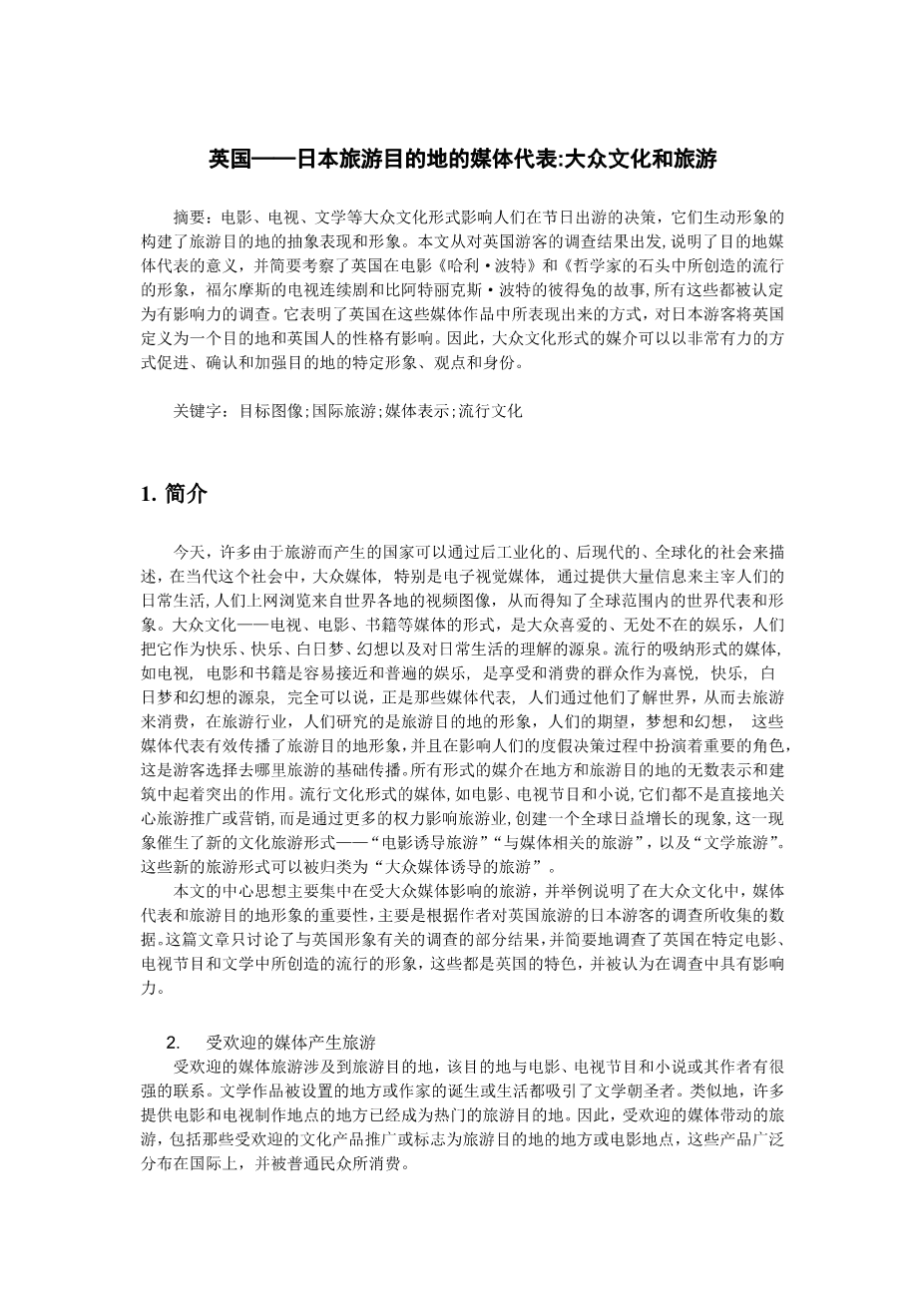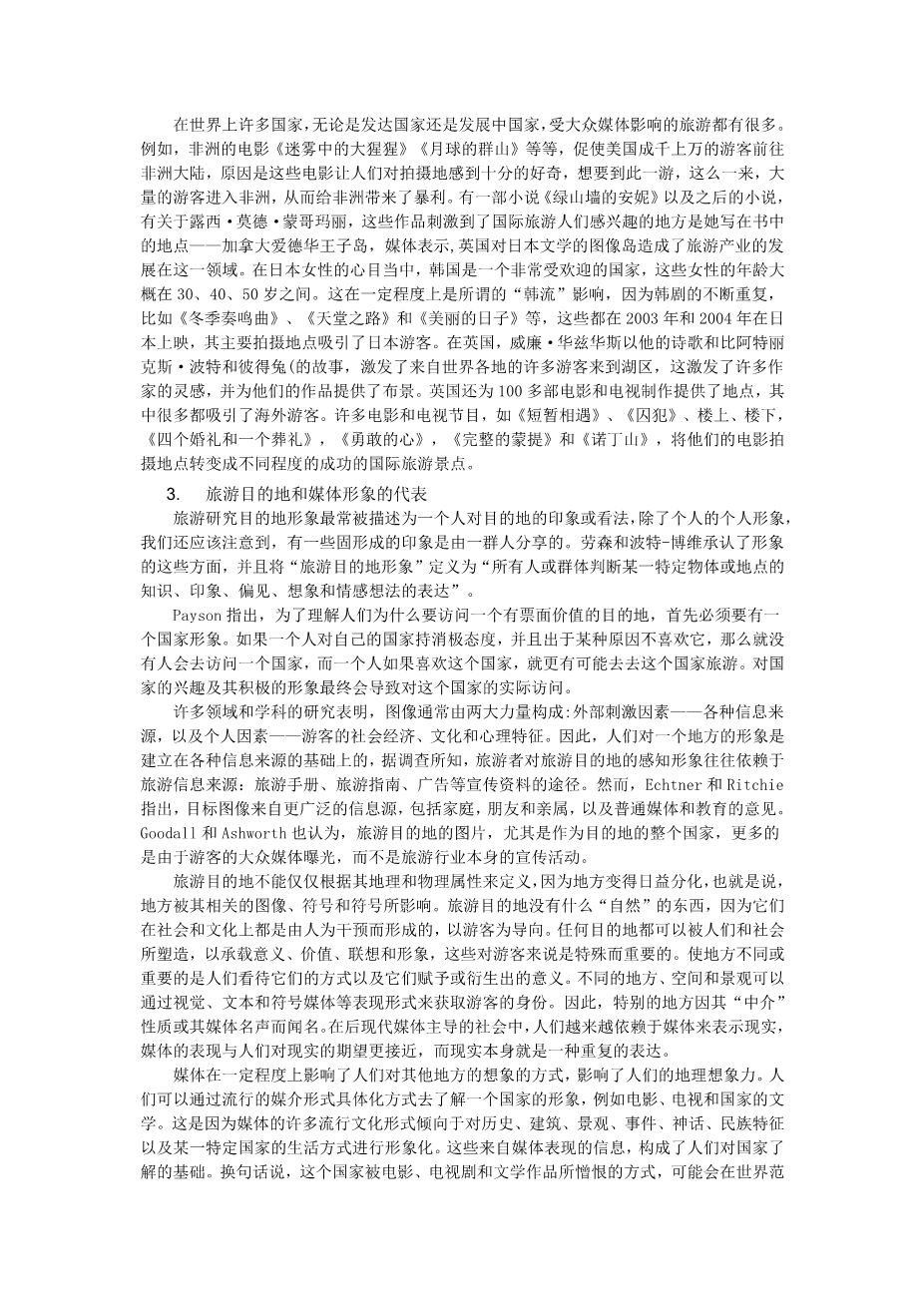Media representation of the UK as a destination for Japanese tourists: Popular culture and tourism
abstract Representations and images of tourist destinations constructed by popular cultural forms of media such as films, television and literature play a significant role in influencing people’s holiday decision-making process. This article illustrates the significance of media representations of destinations based upon findings from the author’s survey of Japanese tourists to the UK and briefly examines popular images of the UK created in the film Harry Potter and the Philosopher’s Stone, the television series of Sherlock Holmes, and Beatrix Potter’s Peter Rabbit stories, all of which were identified as influential in the survey. It suggests that the ways in which the UK is represented in those media works have implications for the ways in which Japanese tourists define the UK as a destination and the character of the British. Thus, popular cultural forms of the media can promote, confirm and reinforce particular images, views, and identities of destinations in a very powerful manner.
keywords destination images; international tourism; media representations; popular culture
1.Introduction
Many tourist-generating nations can be characterized today by post-industrial, postmodern, globalized societies in which media, in particular electronic visual media, dominate people’s everyday life by providing a vast amount of informa- tion, representations and images of the world on a global scale. Popular cultur- al forms of the media such as television, films and books are accessible and pervasive entertainment that is enjoyed and consumed by masses of people as a source of joy, pleasure, daydreaming, and fantasy as well as understanding of the world in everyday life (Carey, 1988). It can be argued that it is those media rep- resentations and images that people actually consume rather than realities, and Through which they understand the world. In tourism, which is said to trade in tourist studies images, expectations, dreams, and fantasies (Selwyn, 1996; Squire, 1996), those media representations and images of tourist destinations play a significant role in influencing people’s holiday decision-making process as the basis upon which tourists make choices about where to visit (Gunn, 1972; Hunt, 1975; Gartner,1989; Butler, 1990; Stabler, 1990; Echtner and Ritchie, 1991).
The media in all their forms play a prominent role in myriad representations and constructions of places and tourist destinations. Popular cultural forms of the media such as films, television programmes and novels, which are not direct- ly concerned with tourism promotion or marketing, have increasingly exerted the power to influence tourism, creating a growing worldwide phenomenon whereby tourists visit a destination as a result of it being featured in a book, film or on TV. This phenomenon has created new forms of cultural tourism – ‘movie-induced tourism’ (Riley et al., 1998),‘media-related tourism’ (Busby and Klug, 2001: 316), and ‘literary tourism’ (Butler, 1990). These new forms of tourism can be grouped as ‘popular media-induced tourism’.
This article considers popular media-induced tourism and illustrates the sig- nificance of media representation and images of tourist destinations construct- ed in popular culture, drawing primarily upon data collected in the author’s survey of Japanese tourists to the United Kingdom of Great Britain (the UK). This article discusses only partial findings of the survey related to images of the UK and briefly examines the popular images of the UK created in specific films, television programmes and literature which feature the UK and were identified as influential in the survey.
2.Popular media-induced tourism
Popular media-induced tourism involves tourist visits to a destination which has strong associations or connections with films, television programmes and novels (literary depictions and figures) or their authors (Squire, 1993; Riley et al., 1998). Places where literary works were set or writers were born or lived have always attracted literary pilgrims. Similarly, many places that provided locations for films and television productions have become popular tourist destinations. Popular media-induced tourism thus involves places or film locations which have been popularized or signified as tourist destinations by those popular cul- tural products, which are widely and internationally distributed and consumed by groups of ordinary people.
Popular media-induced tourism abounds in many countries, involving both developed and developing countries in the world. For example, films set in Africa such as Out of Africa (1985), Gorillas in the Mist (1988), and Mountains of the Moon (1990) prompted thousands of visitors from the United States to visit the African continent due to the windfall exposure of Africa provided by those films (Coloccia, 1997). A novel, Anne of Green Gables as well as subsequent novels written by Lucy Maud Montgomery stimulated international tourist interest in the places she wrote about in Prince Edward Island of Canada and Iwashita Media representation of the UK for Japanese literary images of the island have contributed to the development of the tourism industry in that area (Squire, 1996). In Japan, South Korea has recently been a very popular destination for Japanese women aged in their 30s, 40s and 50s.This is partly due to the so-called ‘Korean Wave’ that surged through continued repeats of Korean television dramas such as Winter Sonata, Stairway to Heaven and Beautiful Days, all of which were shown in 2003 and 2004 in Japan and whose major filming locations have attracted Japanese tourists.In the UK,William Wordsworth with his poems and Beatrix Potter with her Peter Rabbit stories have motivated
剩余内容已隐藏,支付完成后下载完整资料


英语译文共 7 页,剩余内容已隐藏,支付完成后下载完整资料
资料编号:[468374],资料为PDF文档或Word文档,PDF文档可免费转换为Word
您可能感兴趣的文章
- COVID-19时期的旅游业和可持续发展:以西班牙为例外文翻译资料
- 农民相对剥夺感对乡村旅游可持续发展的影响机制外文翻译资料
- 校园大学生的旅行行为——以亚洲某乡村大学为例外文翻译资料
- 内容旅游与地方社区响应:鹫宫的“幸运之星”和“协作动漫旅游”外文翻译资料
- 基于符号互动理论的遗产旅游资源开发与重塑——以良渚古城遗址为例外文翻译资料
- 在TikTok上映射互联网名人:探索注意力、经济和可见性劳动力外文翻译资料
- 基于社区游客视角的环境责任行为的概念和度量外文翻译资料
- 温泉小镇的再造:维希的独特案例——副标题外文翻译资料
- 基于IP理念的桐乡丰子恺文化旅游开发研究外文翻译资料
- 特殊事件对旅游业的影响及其应对措施研究——新冠肺炎疫情对全球旅游业的影响及其应对措施外文翻译资料


